United States
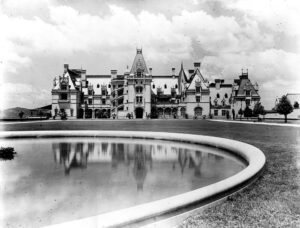
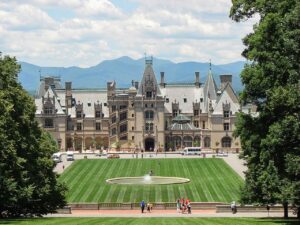 During what became known as the Gilded Age in United States history, extending roughly from 1870 to 1900, the economy grew so rapidly that the wages of Americans, especially in the Northern and Western United States actually surpassed the wages in Europe, especially for skilled workers. Still, increased industrialization demanded an increased unskilled labor force too, so the there was an influx of millions of European immigrants looking for a better life, to fill the need for workers. Basically, the Gilded years were years of overwhelming extravagance.
During what became known as the Gilded Age in United States history, extending roughly from 1870 to 1900, the economy grew so rapidly that the wages of Americans, especially in the Northern and Western United States actually surpassed the wages in Europe, especially for skilled workers. Still, increased industrialization demanded an increased unskilled labor force too, so the there was an influx of millions of European immigrants looking for a better life, to fill the need for workers. Basically, the Gilded years were years of overwhelming extravagance.
While many of the estates of the Gilded Age were in the Eastern United States, not all the great estates were in places like New York City or Newport, Rhode Island. Some of the very wealthy apparently didn’t really like the Northern winter climates, so they chose to build their estates in areas of the South. One of the greatest of these southern estates was the Biltmore Estate near Asheville, North Carolina, The estate was built by George Washington Vanderbilt II between 1889 and 1896, and it is enormous!! The estate covers nearly 11 miles. Of course, the real difference between what we would consider a mansion, and the Gilded Era estates is the fact that the grounds are as extravagant as the homes. The main house of the Biltmore Estate has nearly 200,000 square feet!! Most of us consider a nice sized house to be 2,000 to 3,000 square feet, so 200,000 square feet, for me at least, is beyond what I can even imagine in a house. The construction was a huge undertaking, that literally took building an entire working village near the site to house the workers, manufacturers, and supplies. A three-mile railroad spur was even built just to transport building supplies to the construction site. More than 1,000 workers were hired to build the huge house.
The Biltmore remains in the ownership of the Vanderbilt family, with at least one member of the family living there until 1956, at which point it was operated as a historic museum. It is the largest privately owned home in the United States. To help with the high cost of modern maintenance and expenses, the house and grounds are 
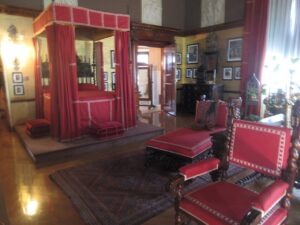 open to the public, for a price, and a number of ticketed events are held on the site throughout the year. At the request of the City of Asheville, which hoped to revitalize the area with tourism, and in an attempt to bolster the estate’s finances during the Great Depression, Cornelia and her husband opened Biltmore to the public in March 1930 at the request of the City of Asheville.
open to the public, for a price, and a number of ticketed events are held on the site throughout the year. At the request of the City of Asheville, which hoped to revitalize the area with tourism, and in an attempt to bolster the estate’s finances during the Great Depression, Cornelia and her husband opened Biltmore to the public in March 1930 at the request of the City of Asheville.
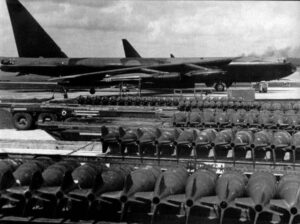 Why would the United States secretly bomb a neutral nation in the middle of a war with an enemy nation? That is the question I have been asking myself concerning the Menu Bombings…the bombing of neutral Cambodia during the Vietnam war. It was thought that bombing supply routes in Cambodia would weaken the enemies of the United States. I’m not sure that worked exactly. It did cut off the supply line, but innocent people were caught in the crossfire. Nevertheless, the decision was made to bomb Cambodia, and also to keep it a secret from the American public, who would most likely feel about it the same way, I do. Intentionally bombing innocent people just rubs most of us the wrong way.
Why would the United States secretly bomb a neutral nation in the middle of a war with an enemy nation? That is the question I have been asking myself concerning the Menu Bombings…the bombing of neutral Cambodia during the Vietnam war. It was thought that bombing supply routes in Cambodia would weaken the enemies of the United States. I’m not sure that worked exactly. It did cut off the supply line, but innocent people were caught in the crossfire. Nevertheless, the decision was made to bomb Cambodia, and also to keep it a secret from the American public, who would most likely feel about it the same way, I do. Intentionally bombing innocent people just rubs most of us the wrong way.
On March 15, 1969, President Richard Nixon approved the plan to bomb Cambodia. The actual missions began 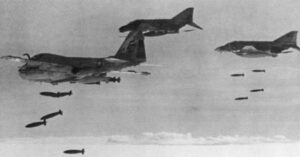 on March 18, 1969, when US B-52 bombers are diverted from their targets in South Vietnam to attack suspected communist base camps and supply areas in Cambodia for the first time in the war. This mission, originally intended to be called Operation Breakfast, and subsequent B-52 strikes inside Cambodia became known as the “Menu” bombings. The strikes included a total of 3,630 flights over Cambodia dropping 110,000 tons of bombs during a 14-month period through April 1970. This bombing of Cambodia and all follow up “Menu” operations were kept secret from the American public and the US Congress because Cambodia was considered a neutral nation. The missions had to be kept secret to avoid a public outcry…so, an intricate reporting system was established at the Pentagon to prevent disclosure of the bombing.
on March 18, 1969, when US B-52 bombers are diverted from their targets in South Vietnam to attack suspected communist base camps and supply areas in Cambodia for the first time in the war. This mission, originally intended to be called Operation Breakfast, and subsequent B-52 strikes inside Cambodia became known as the “Menu” bombings. The strikes included a total of 3,630 flights over Cambodia dropping 110,000 tons of bombs during a 14-month period through April 1970. This bombing of Cambodia and all follow up “Menu” operations were kept secret from the American public and the US Congress because Cambodia was considered a neutral nation. The missions had to be kept secret to avoid a public outcry…so, an intricate reporting system was established at the Pentagon to prevent disclosure of the bombing.
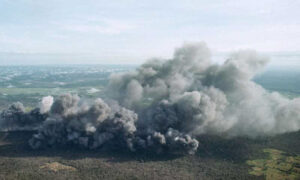
Somehow, the story was leaked by the New York Times in May of 1969, but there was little adverse public reaction. Now I find that incredible. The people were so “asleep” that they hardly noticed the bombing of a neutral country. It makes me wonder just how long the people have been asleep. How could people simply take no notice of such a huge violation of the rules of war. I’m sure there are things I don’t know about this war…lots of things, in fact, but I don’t think it is proper for our government to hide things for the people…especially such a big set of bombing missions on a neutral country. The people of this nation need to open our eyes and watch what our government is doing…before it’s too late.
 Amazingly, the islands of the world have held an importance during wartime, that most of us would never have dreamed. These seemingly insignificant places proved to be great staging places time and again, and so became places that were fought over viciously. The Solomon Islands were among those places fought over during World War II…most specifically Guadalcanal. The island of Guadalcanal is the largest of the Solomons Islands, which is in the South Pacific Ocean, located northeast of Australia. The Solomon Islands are a group of 992 islands and atolls, 347 of which are inhabited. The Solomons have 87 Indigenous languages. They were first discovered in 1568 by Spanish navigator Alvaro de Mendana de Neyra (1541-95). By 1893, the British had annexed Guadalcanal, along with the other central and southern Solomons, which made sense, since they also owned Australia. In 1885, the Germans took control of the northern Solomons, but transferred these islands, except for Bougainville and Buka (which eventually went to the Australians) to the British in 1900. So, the Solomon Islands have been transferred around some over the centuries, as most countries have been, a time or two anyway.
Amazingly, the islands of the world have held an importance during wartime, that most of us would never have dreamed. These seemingly insignificant places proved to be great staging places time and again, and so became places that were fought over viciously. The Solomon Islands were among those places fought over during World War II…most specifically Guadalcanal. The island of Guadalcanal is the largest of the Solomons Islands, which is in the South Pacific Ocean, located northeast of Australia. The Solomon Islands are a group of 992 islands and atolls, 347 of which are inhabited. The Solomons have 87 Indigenous languages. They were first discovered in 1568 by Spanish navigator Alvaro de Mendana de Neyra (1541-95). By 1893, the British had annexed Guadalcanal, along with the other central and southern Solomons, which made sense, since they also owned Australia. In 1885, the Germans took control of the northern Solomons, but transferred these islands, except for Bougainville and Buka (which eventually went to the Australians) to the British in 1900. So, the Solomon Islands have been transferred around some over the centuries, as most countries have been, a time or two anyway.
During World War II, Guadalcanal became a hard-fought-over island, with the Japanese in control in early 1943. Then, on February 8, 1943, Japanese troops evacuate Guadalcanal, leaving the island in Allied possession after a prolonged campaign. When Japan lost Guadalcanal, it paved the way for other Allied wins in the Solomon Islands.
The Japanese had invaded the Solomon Islands in 1942 during World War II and immediately began building a strategic airfield on Guadalcanal. On August 7, 1942, US Marines landed on the island, signaling the Allies’ first major offensive against Japanese-held positions in the Pacific. The Japanese response to the US Marines “boots on the ground” was to quickly launch sea and air attacks. The battles that followed were bloody and made even more miserable in the debilitating tropical heat. Nevertheless, the Marines fought hard with Japanese troops on land, and in the waters surrounding Guadalcanal, the US Navy fought six major engagements with the Japanese between August 24 and November 30. In mid-November 1942, the five Sullivan brothers from Waterloo, Iowa, died together when the Japanese sank their ship, the USS Juneau. These days they try not to put brother together in battle, but the Sullivan brothers had requested it, and so it was granted.
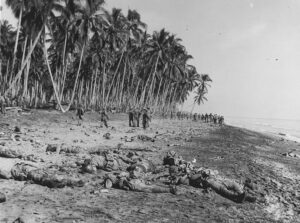
Both the United States and the Japanese suffered heavy losses of men, warships, and planes in the battle for Guadalcanal. It is estimated 1,600 US troops were killed and over 4,000 were wounded. Several thousand more died from disease. The Japanese lost 24,000 soldiers. Finally, on December 31, 1942, Emperor Hirohito told his troops they could withdraw from the area. About five weeks later, the Americans secured Guadalcanal. American authorities declared Guadalcanal secure on February 9, 1943. After the war, American and Japanese groups have repeatedly visited Guadalcanal to search for remains of missing soldiers. Some 7,000 Japanese remain missing on the island, and islanders still bring the Japanese groups bones that the islanders say are those of unearthed Japanese soldiers.
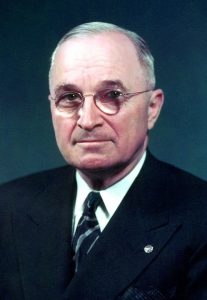 Some presidents are destined to greatness, and some are thrown into it. Some qualify in both categories. President Harry S Truman was born in Lamar, Missouri, on May 8, 1884. He was the oldest child of John Anderson Truman and Martha Ellen Young Truman. As is often tradition in families, he was named for his maternal uncle, Harrison “Harry” Young. His middle initial, “S” was to honor his grandfathers, Anderson Shipp Truman and Solomon Young. Truman’s brother, John Vivian, was born soon after he was, followed by sister Mary Jane.
Some presidents are destined to greatness, and some are thrown into it. Some qualify in both categories. President Harry S Truman was born in Lamar, Missouri, on May 8, 1884. He was the oldest child of John Anderson Truman and Martha Ellen Young Truman. As is often tradition in families, he was named for his maternal uncle, Harrison “Harry” Young. His middle initial, “S” was to honor his grandfathers, Anderson Shipp Truman and Solomon Young. Truman’s brother, John Vivian, was born soon after he was, followed by sister Mary Jane.
President Truman was the 33rd President of the United States, becoming president after the death of President Franklin D Roosevelt. He was a lifetime Democrat, although he might not recognize the party today, and as we have seen, there are good and bad politicians in both parties. Following the death of Roosevelt, who was rather anti-Israel, Truman implemented the Marshall Plan to rebuild the economy of Western Europe and established both the Truman Doctrine and NATO to contain the expansion of communism. He went on to propose numerous liberal domestic reforms, but few were enacted by the Conservative Coalition that dominated the Congress at 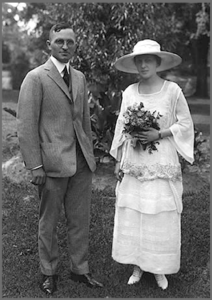 that time. While some of his policies, were not good for America or the world, he was known for his support of Israel. On May 14, 1948, Prime Minister David Ben-Gurion read the proclamation of nationhood. Striking the speaker’s table for emphasis, he announced, “The name of our state shall be Israel.” It was a noble effort, but the new state would need to be recognized to carry much weight.
that time. While some of his policies, were not good for America or the world, he was known for his support of Israel. On May 14, 1948, Prime Minister David Ben-Gurion read the proclamation of nationhood. Striking the speaker’s table for emphasis, he announced, “The name of our state shall be Israel.” It was a noble effort, but the new state would need to be recognized to carry much weight.
Shortly before making his speech, President Truman made some last-minute changes, which are still visible on the speech. The American statement recognized the new State of Israel. Israel’s American recognition came shortly after midnight in Palestine, just a few minutes after the new nation was proclaimed. There were a number of nations who did not want Israel to be a nation again, but President Truman took matters into his own hands, and it became a reality. For his help, President Truman was gifted a Torah from Dr Chaim Weizmann, who was the first president of the new state of Israel, during Weizmann’s visit to the White House on May 25th, 1948. I suppose some people might disagree, but for me, this was the crowning moment of Truman’s presidency.
After his wartime service, Truman returned to Independence, where he married Bess Wallace on June 28, 1919. 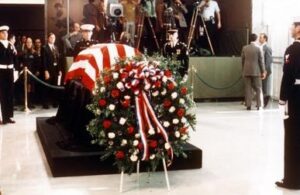 The couple had one child, Mary Margaret Truman. On December 5, 1972, Truman was admitted to Kansas City’s Research Hospital and Medical Center with pneumonia. He developed multiple organ failure, fell into a coma, and died at 7:50am on December 26, 1972, in Independence, Missouri at the age of 88. Bess Truman opted for a simple private service at the library rather than a state funeral in Washington. A week after the funeral, foreign dignitaries and Washington officials attended a memorial service at Washington National Cathedral. Bess died in 1982 and is buried next to Harry at the Harry S Truman Library and Museum in Independence, Missouri.
The couple had one child, Mary Margaret Truman. On December 5, 1972, Truman was admitted to Kansas City’s Research Hospital and Medical Center with pneumonia. He developed multiple organ failure, fell into a coma, and died at 7:50am on December 26, 1972, in Independence, Missouri at the age of 88. Bess Truman opted for a simple private service at the library rather than a state funeral in Washington. A week after the funeral, foreign dignitaries and Washington officials attended a memorial service at Washington National Cathedral. Bess died in 1982 and is buried next to Harry at the Harry S Truman Library and Museum in Independence, Missouri.
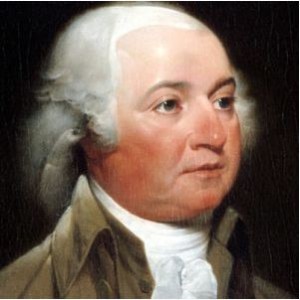 His Elective Majesty…sounds almost laughable, but it was almost the proper way to address the President of the United States, a fact that some presidents would probably have liked very much. Some presidents have tried to “rule” as a king would have, so they figure, why not buy in whole heartedly. One such president, who in fact made the original suggestion of title, was none other than, at the time, Vice President John Adams. The idea came from the fact that other heads of state are known by honorifics such as “His Excellency” and such, but United States presidents are only ever Mr President…or “sir” in a pinch. I’m sure that John Adams already had his sights set on becoming president at some point, and the second president of the United States seemed as good a time to run as any…or maybe he liked his own idea very much.
His Elective Majesty…sounds almost laughable, but it was almost the proper way to address the President of the United States, a fact that some presidents would probably have liked very much. Some presidents have tried to “rule” as a king would have, so they figure, why not buy in whole heartedly. One such president, who in fact made the original suggestion of title, was none other than, at the time, Vice President John Adams. The idea came from the fact that other heads of state are known by honorifics such as “His Excellency” and such, but United States presidents are only ever Mr President…or “sir” in a pinch. I’m sure that John Adams already had his sights set on becoming president at some point, and the second president of the United States seemed as good a time to run as any…or maybe he liked his own idea very much.

Apparently, thinking that the office of the President of the United States needed a title with more grandeur, Adams suggested that a president should be referred to as either “His Elective Majesty,” “His Mightiness,” or the slightly excessive “His Highness, the President of the United States of America and the Protector of their Liberties.” Just imagine any of those ideas. Every one of them make me giggle. Just take a moment to say (out loud) those titles in connection with the president…any president. With some presidents, any one of these titles is hilarious, and I’ll let you to decide to whom that statement applies, because these days we all have very specific opinions on the matter.
In those days, Washington was very aware of public fear about their newly won democracy slipping back into a 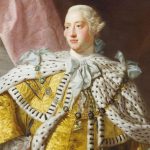 monarchy. They didn’t want this new nation to be too similar to England. They didn’t want this newly free nation to become once again ruled by a different kind of monarchy. So, they refused to allow the president to be titled as anything other than “The President of the United States.” They were right, of course, because the United States is not a “spin-off” of England…like England 2.0. The United States is a very unique nation…unlike any other, before her or after her. This nation was founded by people who refused to be told what to believe anymore. That is why they left England, where they were forced to live under a “state religion.” The nation was founded as “one nation, under God.” We would not have a king, because Jesus was our King of kings. We couldn’t give that title to a mere man.
monarchy. They didn’t want this new nation to be too similar to England. They didn’t want this newly free nation to become once again ruled by a different kind of monarchy. So, they refused to allow the president to be titled as anything other than “The President of the United States.” They were right, of course, because the United States is not a “spin-off” of England…like England 2.0. The United States is a very unique nation…unlike any other, before her or after her. This nation was founded by people who refused to be told what to believe anymore. That is why they left England, where they were forced to live under a “state religion.” The nation was founded as “one nation, under God.” We would not have a king, because Jesus was our King of kings. We couldn’t give that title to a mere man.
 When the United States Army sends in the Army Special Forces, they are sending their very best people. It’s not that all of our soldiers aren’t the best in the world, because they are, but the Special Forces, also known as the “Green Berets” due to their distinctive service headgear, are a special operations force of the United States Army that are “designed to deploy and execute nine doctrinal missions: unconventional warfare, foreign internal defense, direct action, counter-insurgency, special reconnaissance, counter-terrorism, information operations, counterproliferation of weapons of mass destruction, and security force assistance. The first two missions, unconventional warfare and foreign internal defenses, emphasize language, cultural, and training skills in working with foreign troops. Other Special Forces missions, known as secondary missions, include: combat search and rescue (CSAR), counter-narcotics, hostage rescue, humanitarian assistance, humanitarian demining, information operations, peacekeeping, and manhunts.” Normally, the Special Forces teams are the ones sent in to rescue the other
When the United States Army sends in the Army Special Forces, they are sending their very best people. It’s not that all of our soldiers aren’t the best in the world, because they are, but the Special Forces, also known as the “Green Berets” due to their distinctive service headgear, are a special operations force of the United States Army that are “designed to deploy and execute nine doctrinal missions: unconventional warfare, foreign internal defense, direct action, counter-insurgency, special reconnaissance, counter-terrorism, information operations, counterproliferation of weapons of mass destruction, and security force assistance. The first two missions, unconventional warfare and foreign internal defenses, emphasize language, cultural, and training skills in working with foreign troops. Other Special Forces missions, known as secondary missions, include: combat search and rescue (CSAR), counter-narcotics, hostage rescue, humanitarian assistance, humanitarian demining, information operations, peacekeeping, and manhunts.” Normally, the Special Forces teams are the ones sent in to rescue the other  soldiers, or at least to drag them out of a sticky situation, but on this occasion, it was the Special Forces team that needed to be rescued.
soldiers, or at least to drag them out of a sticky situation, but on this occasion, it was the Special Forces team that needed to be rescued.
While returning to base from another mission, Air Force 1st Lieutenant James P Fleming and four other Bell UH-1F helicopter pilots received an urgent message from an Army Special Forces team. The pilots were told that the team was pinned down by enemy fire. Several of the other helicopter pilots had to leave the area because they were low on fuel, but Lieutenant Fleming and another pilot pressed on with the rescue effort. While the first attempt failed because of intense ground fire, they refused to abandon the Army green berets. Then, Fleming managed to land and pick up the team. Against all odds, he safely arrived at his base near Duc Co, at which time it was discovered that his helicopter was nearly out of fuel. For his lifesaving efforts, Lieutenant Fleming was later awarded the Medal of Honor for his actions. It was a selfless act, that could have cost him his life, but Lieutenant Fleming didn’t even consider his own life. He only thought about the others.
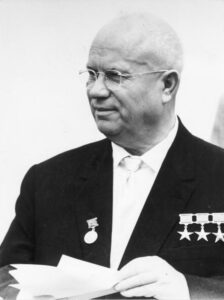 It’s never a good idea to find your nation behind it’s enemies in the arms race. Never was that made more clear than during the Cold War. It’s also not a good idea to begin to brag to your enemies about the superiority of your nation over theirs concerning the nation’s arms race status. Nevertheless, in a long and rambling interview with an American reporter on November 15, 1957, Soviet leader Nikita Khrushchev claimed that the Soviet Union had missile superiority over the United States. He then went on to challenge America to a missile “shooting match” to prove his assertion. It was a bold move, and one that fueled fears in the United States that the nation was indeed falling behind the Soviets in the arms race. People began to worry about not only the idea of the United States falling behind in the arms race, but also the idea that the Soviet Union and Nikita Khrushchev might actually launch their missiles at the US.
It’s never a good idea to find your nation behind it’s enemies in the arms race. Never was that made more clear than during the Cold War. It’s also not a good idea to begin to brag to your enemies about the superiority of your nation over theirs concerning the nation’s arms race status. Nevertheless, in a long and rambling interview with an American reporter on November 15, 1957, Soviet leader Nikita Khrushchev claimed that the Soviet Union had missile superiority over the United States. He then went on to challenge America to a missile “shooting match” to prove his assertion. It was a bold move, and one that fueled fears in the United States that the nation was indeed falling behind the Soviets in the arms race. People began to worry about not only the idea of the United States falling behind in the arms race, but also the idea that the Soviet Union and Nikita Khrushchev might actually launch their missiles at the US.
Khrushchev tried to compare the arms race to the space race, saying that if the United States had intercontinental ballistic rockets, “she had would have launched her own Sputnik.” Khrushchev was crossing boastful belligerence and calls for “peaceful coexistence” with the West, in what was a classic move for him. He bragged about Soviet missile superiority, claiming that the United States did not have what the Soviet Union had. Then, as cool as a cucumber, he issued a challenge, saying, “Let’s have a peaceful rocket contest just like a rifle-shooting match, and they’ll see for themselves.”
Following his fear-inspiring statements, Khrushchev began to speak about the future of East-West relations, saying that the American and Soviet people both wanted peace. He cautioned that although the Soviet Union would never start a war, “some lunatics” might bring about a conflict. In particular, he noted that Secretary of State John Foster Dulles had created “an artificial war psychosis.” In the case of war, it “would be fought on the American continent, which can be reached by our rockets.” NATO forces in Europe would also be devastated, and Europe “might become a veritable cemetery.” While the Soviet Union would “suffer immensely,” the forces of communism would ultimately destroy capitalism.
Khrushchev made these remarks just a few days after the Gaither Report had been leaked to the press in the 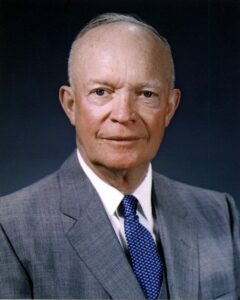 United States. The report supported many of the Russian leader’s contentions, charging that the United States was falling far behind the Soviets in the arms race. Of course, the critics of President Dwight D Eisenhower’s foreign policy, especially the Democratic Party, went on the attack, calling Eisenhower weak. The Gaither Report called for “an urgent strengthening of US missile technology, along with offensive and defensive military capabilities. The report also called for a fifty percent increase in US military spending and a redesign of the US Defense Department.” The Gaither Report was presented to President Eisenhower on November 7, 1957. The report suggested that Eisenhower’s military policy…the reliance on cheap nuclear weapons instead of expensive Army divisions…was inadequate. He kept the Report secret and generally ignored it, but its conclusions were leaked to the press. The public debate concerning the alleged “missile gap” between US and Soviet rocket arsenals continued through the early 1960s and became a major issue in the 1960 presidential campaign between Richard Nixon and John F Kennedy.
United States. The report supported many of the Russian leader’s contentions, charging that the United States was falling far behind the Soviets in the arms race. Of course, the critics of President Dwight D Eisenhower’s foreign policy, especially the Democratic Party, went on the attack, calling Eisenhower weak. The Gaither Report called for “an urgent strengthening of US missile technology, along with offensive and defensive military capabilities. The report also called for a fifty percent increase in US military spending and a redesign of the US Defense Department.” The Gaither Report was presented to President Eisenhower on November 7, 1957. The report suggested that Eisenhower’s military policy…the reliance on cheap nuclear weapons instead of expensive Army divisions…was inadequate. He kept the Report secret and generally ignored it, but its conclusions were leaked to the press. The public debate concerning the alleged “missile gap” between US and Soviet rocket arsenals continued through the early 1960s and became a major issue in the 1960 presidential campaign between Richard Nixon and John F Kennedy.
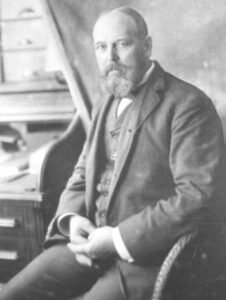
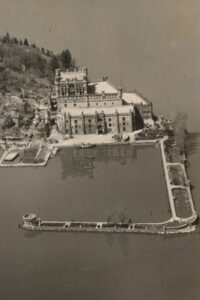 We don’t often think of the United States having castles, but some do exist. Most are not considered true castles, but are rather country houses, follies, or other types of buildings built to give the appearance of a castle. In architecture, a folly is a building constructed primarily for decoration, but suggesting through its appearance some other purpose, or of such extravagant appearance that it transcends the range of usual garden buildings. Castles seem like almost ancient history items to most of us, and when it came to the United States, many people thought of the Old West and homestead type dwellings. Nevertheless, there are a few real castles here in the United States, even if we don’t have royalty here.
We don’t often think of the United States having castles, but some do exist. Most are not considered true castles, but are rather country houses, follies, or other types of buildings built to give the appearance of a castle. In architecture, a folly is a building constructed primarily for decoration, but suggesting through its appearance some other purpose, or of such extravagant appearance that it transcends the range of usual garden buildings. Castles seem like almost ancient history items to most of us, and when it came to the United States, many people thought of the Old West and homestead type dwellings. Nevertheless, there are a few real castles here in the United States, even if we don’t have royalty here.
One such castle is Bannerman Castle in New York. The castle is located on Pollepel Island, about 50 miles north of New York City, on the Hudson River. The castle is in serious disrepair, but the Bannerman Castle Trust, Inc is trying to shore up the buildings so they don’t deteriorate further. The analysis that has been done indicates that 5 out of the 7 buildings on the island could be shored up. The others are too far gone. The castle has a strange history, and I suppose some would debate it’s claim as a true castle. The castle was built by Frank Bannerman VI over a period of 17 years. The island’s buildings were personally designed by Bannerman without professional help from architects, engineers, or contractors. The island has buildings, docks, turrets, garden walls, and a moat in the style of old Scottish castles. That was his passion. He loved Scottish castles and built his castle with a Scottish flare. All of the buildings are elaborately decorated, from biblical quotations cast into all fireplace mantles, to a shield between the towers with a coat of arms, and a wreath of thistle leaves and flowers.
Bannerman’s family immigrated to America in 1854, when he was three. They settled in Brooklyn, New York, where his father established a business selling flags, rope, and other articles acquired at Navy auctions. He was a patriotic man, who joined the union army during the Civil War. At that time young Frank began running the business. He was 13 years old. When the Civil War ended, the US government auctioned off military goods by the ton, mostly to be scrapped for their metal. It was young Frank who saw the importance of these materials, and it was his wise purchases that earned him the moniker “Father of the Army-Navy Store.” He could see that much of what was being sold had a market value higher than scrap. Under the guidance of the younger Bannerman, the Bannerman family became the world’s largest buyer of surplus military equipment. By this time, their storeroom and showroom took up a full block at 501 Broadway. Bannerman made his store into a type of museum/store. It opened to the public in 1905. Of it, the New York Herald said, “No museum in the world exceeds it in the number of exhibits.”
Frank was very prosperous, and it was during a business trip to Ireland that he met his future wife, Helen Boyce. They had three children. At the close of the Spanish American War, Frank Bannerman purchased 90 
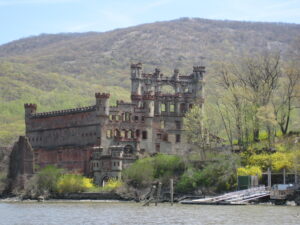 percent of all captured goods in a sealed bid. After that, it became necessary to find a secure place to store their large quantity of very volatile black powder. His son, David saw Pollepel Island, in the Hudson, and Frank Bannerman purchased it in 1900. Following the purchase, the building of the castle began. Today, the island is owned by the state of New York, and at this time visits are prohibited until the buildings can be made safer.
percent of all captured goods in a sealed bid. After that, it became necessary to find a secure place to store their large quantity of very volatile black powder. His son, David saw Pollepel Island, in the Hudson, and Frank Bannerman purchased it in 1900. Following the purchase, the building of the castle began. Today, the island is owned by the state of New York, and at this time visits are prohibited until the buildings can be made safer.
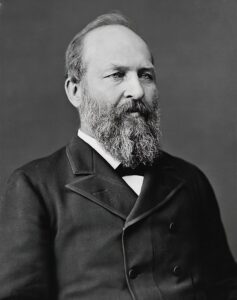 In the history of the United States, 4 presidents have been assassinated. Of course the ones we remember the most are Abraham Lincoln and John F Kennedy. The other two were William McKinley and James Garfield. With Lincoln and Kennedy, death was quick, even though with Lincoln it took until the next day. With McKinley, death came 7 days after he was shot, but with Garfield, death needn’t have come at all.
In the history of the United States, 4 presidents have been assassinated. Of course the ones we remember the most are Abraham Lincoln and John F Kennedy. The other two were William McKinley and James Garfield. With Lincoln and Kennedy, death was quick, even though with Lincoln it took until the next day. With McKinley, death came 7 days after he was shot, but with Garfield, death needn’t have come at all.
President James A Garfield had served as the president for just four months when he was shot on July 2, 1881, by Charles Guiteau in Washington DC. Guiteau had been stalking the president for about a month, and he shot him in the arm and the back. Guiteau wasn’t much of a shot I guess. Garfield didn’t die instantly, and in fact he didn’t die for 11 weeks. In the end, it wasn’t the wounds that caused his death, but rather that the wounds became infected which claimed the president’s life in the end. Had the doctors of that age known more about infection, I believe Garfield might have lived. Infection always comes from exposure to a bacteria or virus. Yes, it could have been introduced by the bullets, but with the proper treatment, the infection could also have been thwarted. Of course, I don’t know if President Garfield would have been able to walk, or move in any other way, because I don’t know how bad the wound in his back was. Nevertheless, a would that took 11 weeks to kill the man, could not have been an infection that could not be healed. Of course, I’m no  doctor, but then modern medicine has many more tools in it’s belt now than it did then. Ironically, when you think about it Garfield was not the only one of the assassinated presidents who faced exposure and lost. The others were exposed to their assassins bullet, a sad but true fact. It’s just that Garfield suffered a much longer length of time than the others…and that is truly awful.
doctor, but then modern medicine has many more tools in it’s belt now than it did then. Ironically, when you think about it Garfield was not the only one of the assassinated presidents who faced exposure and lost. The others were exposed to their assassins bullet, a sad but true fact. It’s just that Garfield suffered a much longer length of time than the others…and that is truly awful.
Apparently, Guiteau was angry because the president didn’t appoint him to the office he desired. That is an insane reason to kill a man, and Guiteau must have been a man who could not control his own emotions…sadly. While the assassinations of Lincoln, Kennedy, and McKinley are still steeped in conspiracy theories and political ideology, Guiteau’s motivations were simple…egomania, delusions of grandeur, and the belief that God had willed him to “remove” Garfield from office. Guiteau failed to become the “great man” he was striving to be, and after being convicted of murder, Guiteau was sentenced to death and was hanged in 1882.
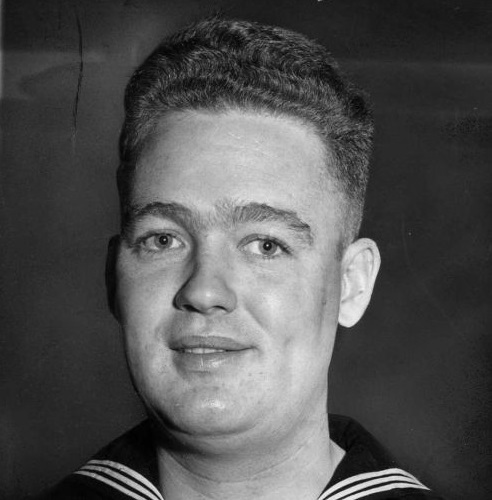

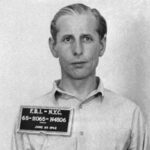 Adolf Hitler was always trying to find a way to infiltrate the nations of the world, because his ultimate goal was to control the world. Most of us would think that he was mostly active in the nations around Germany, and that might be a correct statement, but Hitler also had his sights on the United States. In 1942, Hitler ordered the defense branch of the German Military Intelligence Corps initiated a program to infiltrate the United States and destroy industrial plants, bridges, railroads, waterworks, and Jewish-owned department stores. His ultimate plan was to sabotage all of these, thereby shackling the United States so they would not be an effective enemy in World War II.
Adolf Hitler was always trying to find a way to infiltrate the nations of the world, because his ultimate goal was to control the world. Most of us would think that he was mostly active in the nations around Germany, and that might be a correct statement, but Hitler also had his sights on the United States. In 1942, Hitler ordered the defense branch of the German Military Intelligence Corps initiated a program to infiltrate the United States and destroy industrial plants, bridges, railroads, waterworks, and Jewish-owned department stores. His ultimate plan was to sabotage all of these, thereby shackling the United States so they would not be an effective enemy in World War II.
The Nazis hoped that their sabotage teams would be able to slip into America at the rate of one or two every six weeks…going unnoticed as simple illegal aliens. The first two teams, made up of eight Germans who had all lived in the United States before the war, departed the German submarine base at Lorient, France, in late May. On a heavily foggy June 12, 1942, just before midnight, a German submarine reached the American coast off Amagansett, Long Island. A team was deployed, rowing to the shore in an inflatable boat. Just as the Germans finished burying their explosives in the sand, John C Cullen, a young US Coast Guardsman, came upon them during his regular patrol of the beach. The leader of the team, George Dasch, bribed the suspicious Cullen, and he accepted the money, promising to keep quiet.
At first I found myself feeling angry at the “traitor” John C Cullen, who had sold out his country by accepting a bribe, but then I found out that Cullen was not only not a traitor, but he was a hero and a patriot in every way. As soon as Cullen passed safely back into the fog, he ran two miles back to the Coast Guard station and informed his superiors of his discovery. After retrieving the German supplies from the beach, the Coast Guard called the FBI, which launched a massive manhunt for the saboteurs, who had fled to New York City.
The saboteurs, Dasch and Ernest Burger, were unaware that the FBI was looking for them, but they decided to turn themselves in and betray their colleagues. It might have been because they were afraid they would be captured after the botched landing. On July 15, Dasch called the FBI in New York, but incredibly they failed to take his claims seriously. Dasch decided to travel to FBI headquarters in Washington DC. On July 18, the same day that a second four-man team successfully landed at Ponte Vedra Beach, Florida, Dasch turned himself in. He agreed to help the FBI capture the rest of the saboteurs.
With Dasch’s help, Burger and the rest of the Long Island team were picked up by July 22, 1942 and by July 27, 1942 the whole of the Florida team was arrested. To preserve wartime secrecy, President Franklin D Roosevelt ordered a special military tribunal consisting of seven generals to try the saboteurs. At the end of July, Dasch was sentenced to 30 years in prison, Burger was sentenced to hard labor for life, and the other six Germans were sentenced to die. The six condemned saboteurs were executed by electric chair in Washington 
 DC, on August 8, 1942. The situation was handled so quickly, that it is almost shocking to me. Two more German spies were caught after a landing in Maine in 1944. No other instances of German sabotage within wartime America has come to light. We assume that there were no others, but I don’t suppose we will ever know for sure. Nevertheless, no sabotages were ever carried out during that time.
DC, on August 8, 1942. The situation was handled so quickly, that it is almost shocking to me. Two more German spies were caught after a landing in Maine in 1944. No other instances of German sabotage within wartime America has come to light. We assume that there were no others, but I don’t suppose we will ever know for sure. Nevertheless, no sabotages were ever carried out during that time.

